Picross DS
We'll picross if this isn't a hit in the West.
This review was supposed to be written two days ago. Then it was supposed to be written yesterday. Then it was supposed to be written this morning. Now it's the afternoon and it's still a struggle to stop playing Picross DS for long enough to review it. So it's not just Slitherlink. Picross DS is the latest in the long line of addictive logic puzzle games on Nintendo's handheld that monopolise your every waking moment and imprint themselves on the inside of your eyelids when you're hoping that sleep might offer some respite. So while John Walker gave up on the Game Boy versions of Picross to spend more time with Slitherlink, the release of Picross on the DS might make him want to reconsider.
The chances are that Nintendo's previous picross titles have passed you by, since only one of them (Mario's Picross) got a release outside of Japan, and it was greeted with a groundswell of indifference. Nevertheless, you might be familiar with picross puzzles. Bearing a superficial comparison to Sudoku, Minesweeper and all those, they've appeared in the UK under various names, including Griddler and Nonogram, and in various newspaper puzzle pages (including The Sunday Telegraph and occasional appearance in The Guardian). And they're also freely available across the internet, in varying shades of quality. But they have yet to inflict an onslaught on the commuting classes that's comparable to the enormous success of Sudoku. Which is unfair, because Picross is better than all of its logic puzzle peers (with the possible exception of Slitherlink. Maybe).

Like most logic puzzles, any description is going to be pretty boring: the object is to use logic to shade the correct cells within a grid, in order to produce a rudimentary pixel picture. Imagine, if you can, a grid, with a string of numbers next to each row and column. Those numbers tell you how many contiguous blocks of shaded cells there are in that row or column. So, for example, 2,2,4 tells you that there is a block of two shaded cells; a block of two shaded cells; and a block of four shaded cells; all in a line, in that order, and each separated by at least one unshaded cell. By cross-referencing the strings of numbers you work out which cells to shade, and which cells can't be shaded, and then you use that information to work out where other shaded cells go.
See? Boring. Until you pick it up and play it, and you become ensnared by the relentless urge to create pixel perfect order out of the frightening chaos that is a blank grid. And there's a lot of blank grids. After a tutorial and some Easy puzzles, the game is largely divided across Free puzzles, and Normal puzzles and there are about 150 of each. Free puzzles are the more difficult of the two because if you make a mistake the game lets you continue, and if you make one mistake you can potentially make a lot of mistakes as you use the wrong information to work out where the shaded cells are. Normal mode, by contrast, punishes any mistakes with a time penalty. This makes it possible to use a degree of guesswork to finesse your logic, which is handy for beginners or the hard of thinking, as is the option to start each grid with one randomly assigned row or column filled out.

It's all wrapped up with Nintendo's characteristic sense of charm and accompanied by some particularly sweet sound effects (though you'll want to turn the background music right off). But there is a problem. By far, the biggest problem with Picross DS, apart from the shortage of hours in the day, is the interface. The touchscreen interface is a bit irritating, because it requires you to keep tapping the corner of the screen to switch between shading cells and marking them unshaded, though this is offset by the option to use buttons instead. What's really annoying is that the game uses the lower screen to zoom in when you start to play with bigger grids, making it impossible to scan a whole column or row at a time except by straining your eyes and staring at the top screen. Nevertheless, navigating this compromise does eventually become second nature, and the game does a passable job of keeping your clues onscreen - so it's not perfect, but it's not broken either.
And since it's not broken, any niggling sense of frustration is counterbalanced by the sheer magnitude of the game. If replaying the 300-odd puzzles to improve your time doesn't sound appealing, it's possible to create your own and share them with friends over a wireless connection (and anyway replaying the 300-odd puzzles to improve your time will start to become appealing as the game starts to infect every fibre of your being). It's also possible to get hold of downloadable updates that contain puzzles that were previously included in Nintendo's previous Picross games, and to race your friends online. And there's a whole load of mini-games to unlock, from daily quick-play puzzles to quick-burst reflex tests that require you to tap moving cells.
It is, simply, just about the best version of just about the best logic puzzle out there. So here's hoping that the onslaught of Sudoku and the success of titles like Brain Training will have paved the way for a western release. And that Nintendo can provide us all with a few more hours in the day.







